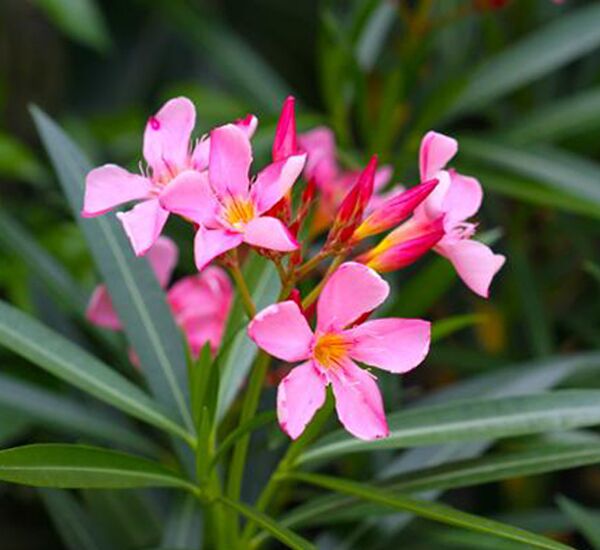Oleander
Oleander is a stunning subtropical favorite that brings vibrant beauty and resilience to any landscape. This evergreen shrub bursts into a heavy bloom of colorful flowers in May, followed by intermittent flushes throughout the summer, making it a standout choice for both commercial and residential gardens. Reaching heights of up to 20 feet, oleanders are typically pruned to a more manageable size, offering versatility in design.
Thriving in full sun and tolerating partial shade, this drought-tolerant plant adapts effortlessly to a wide range of soil types, from heavy clay to well-drained sand. Low-maintenance and rarely needing regular fertilization, the oleander is perfect for gardeners seeking effortless elegance. Be mindful of its susceptibility to insects and disease, and enjoy its robust nature with minimal watering – though a little extra care during the hottest, driest months ensures optimal growth. Elevate your outdoor space with the timeless charm of the oleander, available now at Calloway’s Nursery!
Please contact your local store for product availability.
Find a garden center near you.
How to Care for Oleander
Sunlight: Oleander thrives in full sun. It requires at least 6-8 hours of direct sunlight per day for optimal growth and flowering.
Soil: Plant Oleander in well-drained soil that is rich in organic matter. A pH of 5.0-8.0 is ideal.
Water: Oleander requires regular watering, especially during dry periods. However, avoid overwatering, as this can lead to root rot. Aim to keep the soil consistently moist but not soggy.
Fertilizer: Fertilize Oleander once a month during the growing season with a balanced fertilizer. Avoid fertilizing late in the season, as it can encourage new growth that may not harden off before winter.
Pruning: Prune Oleander immediately after flowering to shape the plant and remove dead or weak branches. Avoid pruning in late summer or fall, as this can stimulate new growth that may not be hardy.
Winter Protection: In colder climates, Oleander may require protection from frost. Wrap the plant with burlap or frost blankets, or move it indoors to a sheltered location.
Pests and Diseases: Oleander can be susceptible to pests like aphids, scale insects, and spider mites. Monitor your plant regularly and take action to control infestations. Oleander is also prone to diseases like powdery mildew and leaf spot. Avoid overhead watering and ensure good air circulation to prevent these problems.
Toxicity: Remember that Oleander is toxic if ingested. Wear gloves when handling the plant, and keep it out of reach of children and pets.
Species: oleander
Plant Height: 60-96 in.
Spread: 96-120 in.
Evergreen: Yes
Plant Form: Upright
Summer Foliage Color: Green
Minimum Sunlight: Full Sun
Maximum Sunlight: Full Sun
Oleanders are subtropical favorites. They bloom heavily in May, and then they'll repeat to lesser degrees through the summer.
Oleanders are an excellent small – large flowering shrub for use in commercial and residential landscapes. Most oleanders do not require regular fertilization. Gardeners should be aware of the following characteristic(s) that may warrant special consideration; Insects Disease.
This evergreen shrub can reach heights of up to 20’ but are most often pruned to a smaller size. Oleanders due best in full sun but will tolerate partial shade. Oleanders are very drought tolerant and many survive without benefit of supplemental irrigation. To achieve “optimum” growth it is necessary to apply water during the hottest/driest months of the year. Oleanders are extremely tolerant of a broad range of soil types, from heavy clay to well-drained sand.
